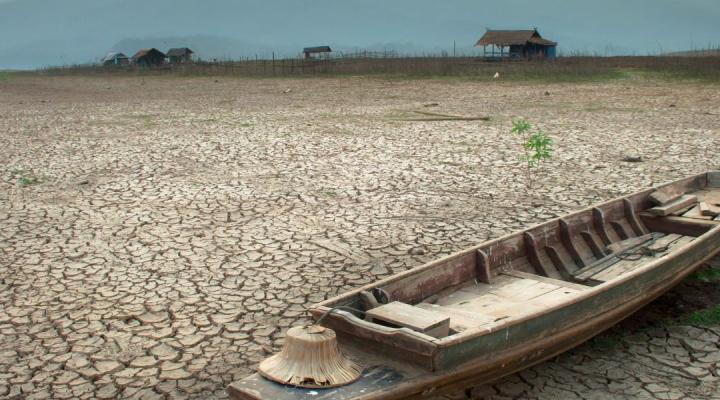By Fatna Ikrame El Fanne, environmental engineer and Co-Founder and Director of Projects, Youth For Climate. Fatna is a judge on the Burjeel Holdings Oxford Saïd Climate Change Challenge and has provided this blog for Oxford Answers.
Climate conflict has arisen as a key worry in a world coping with the grave realities of climate change. The effects of shifting weather patterns, prolonged droughts, and catastrophic weather events are causing havoc in communities and nations all over the world. Among these challenges, there is a ray of hope: the role of youth in leading the fight against climate change.

Understanding climate conflict:
Climate change is more than simply an environmental concern; it is a global threat that has the potential to spark conflict and disrupt society. Climate conflict, often known as climate-induced conflict, refers to a variety of conflicts and disagreements caused by the environmental and socioeconomic effects of climate change. The difficulty of resource scarcity and competitiveness is central to this issue because shifting weather patterns, lengthy droughts, and extreme weather events can affect the supply of essential resources such as water and arable land. As these resources grow scarcer, tensions can escalate, appearing as clashes between communities or even nations, as indicated by UN and World Bank reports.
Moreover, climate change-induced displacement and migration are critical factors in climate conflict. Rising sea levels, desertification, and extreme weather events are causing people to leave their homes, resulting in mass migration. This relocation can strain recipient regions' resources and infrastructure, potentially causing tensions and conflicts. Furthermore, climate change has a disproportionate impact on vulnerable communities, particularly in low-income areas. These groups frequently lack the required resources and infrastructure to adapt to changing climatic circumstances, making them more vulnerable to climate-related conflicts.
Unravelling climate conflict:
One notable example of a climate conflict involves the Lake Chad region in Africa. Lake Chad has shrunk significantly as a result of climate change, rising temperatures, and unsustainable water use. As the lake has drained, water availability for populations relying on it for agriculture, fishing, and other activities has decreased. This environmental stress has contributed to conflicts over scarce resources such as water and arable land among the Lake Chad Basin countries of Nigeria, Chad, Cameroon, and Niger.

The economic and social repercussions of reduced water levels have exacerbated tensions, contributing to vulnerabilities exploited by extremist groups like Boko Haram in recruitment and furthering their agendas. This case underscores the intricate link between climate-related environmental shifts and heightened security risks in vulnerable regions. International bodies, notably various United Nations agencies, have been actively engaged in addressing humanitarian and security challenges in the Lake Chad Basin, emphasising the necessity of sustainable, climate-resilient solutions.
Youth as agents of change:
The emergence of youth as transformative agents in the context of climate conflict signifies a global paradigm shift. Across continents, young activists have assumed leadership roles, spearheading impactful initiatives in climate change mitigation and adaptation. Reports from the United Nations (UN) extensively illustrate the substantial impact of these youth-led initiatives. They showcase a collective drive toward addressing pressing environmental concerns. These initiatives, documented in UN reports, range from community-based projects to large-scale advocacy campaigns, showcasing the efficacy of youth-driven action in catalysing change.

For instance, initiatives like ‘Fridays for Future’ led by Greta Thunberg, have mobilised millions to demand urgent climate action through school strikes and advocacy. Similarly, grassroots efforts such as the ‘Zero Waste Youth Convergence’ in Southeast Asia showcase collaborative endeavours promoting sustainable living practices.
These youth-led actions, as highlighted in UN reports, transcend borders and underscore their efficacy in catalysing environmental awareness and change. Examples like ‘Plant for the Planet’, with its global tree-planting campaigns, demonstrate tangible contributions to combating deforestation and ecosystem restoration.
Notably, these initiatives don't merely create immediate environmental impacts but also influence policy reforms. Movements like the ‘Youth Climate Strike’ have successfully pressured governments for ambitious climate commitments at various levels.
Challenges and opportunities:
Youth engagement in climate activism encounters hurdles like limited resources, financial constraints, and resistance, impeding impactful initiatives. For instance, securing sustainable funding for grassroots projects and facing scepticism towards youth-led efforts pose significant challenges.
However, these challenges also spark opportunities. Education equips youth with vital skills, fostering innovation and promoting initiatives like renewable energy projects and community-based eco-friendly practices. Reports from organisations like the World Bank shed light on these obstacles and successes, guiding policymakers to support young activists and foster innovative solutions for global climate action. This understanding forms a roadmap for stakeholders to empower youth in driving sustainable progress against climate change.
In conclusion, the intertwining threads of climate conflict and youth-led activism form a narrative that demands our attention. The vital role of youth in combatting climate change is irrefutable. As we navigate the complex web of environmental challenges, it is the collective responsibility of societies, governments, and international organisations to support and amplify the voices of the youth. Only through sustained, global efforts can we hope to address the profound implications of climate change and secure a sustainable future for generations to come.
Many thanks to Fatna and the rest of the panel of international judges who are giving their time and expertise to review entries for our Climate Change Challenge. It is a global competition for high school students (aged 15 to 18) and teachers which Burjeel Holdings and Saïd Business School launched in the summer of 2023 ahead of COP28.
The challenge invited young people and educators across the world to contribute their ideas and take action towards creating solutions to the greatest and most complex threat to humanity: the climate crisis.
The winners were announced at COP28, the UN Climate Conference, in Dubai on 2 December.




